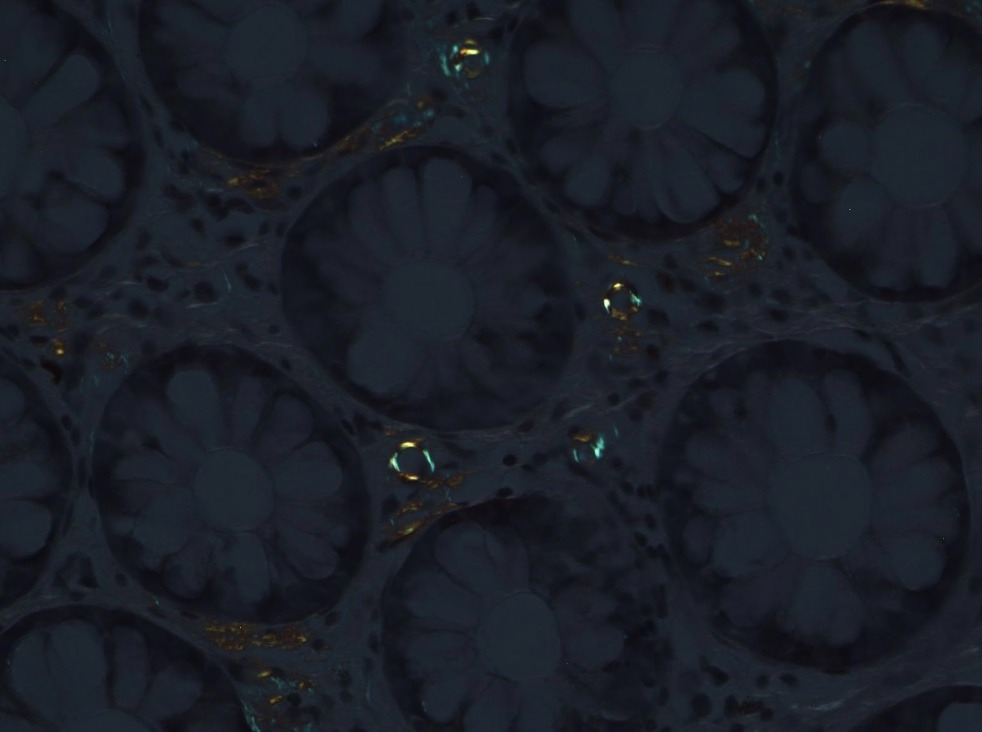Back
Poster Session E - Tuesday Afternoon
E0423 - A Delay in Diagnosis of Crohn’s Disease Presenting as Gastrointestinal Amyloidosis
Tuesday, October 25, 2022
3:00 PM – 5:00 PM ET
Location: Crown Ballroom

Bola Nashed, MD
Ascension St. John Hospital
Detroit, MI
Presenting Author(s)
Bola Nashed, MD, George Gennaoui, DO, Leonid Shamban, DO
Ascension St. John Hospital, Detroit, MI
Introduction: Secondary (AA) Amyloidosis is a known rare complication of Crohn's disease (CD) and Ulcerative colitis (UC). It usually takes years to develop. Here we discuss a patient’s case who presented to us with manifestations of chronic inflammation and gastrointestinal symptoms. She was found to have systemic amyloidosis involving the gastrointestinal tract and endoscopic appearing Crohn's disease.
Case Description/Methods: A 45 year old Caucasian female presented for bidirectional endoscopy for iron deficiency anemia and unintentional weight loss. Her past medical history includes active uveitis and chronic anemia. For years, she struggled with fatigue, arthralgias, bloating, and alternating constipation and diarrhea. She was treated by her rheumatologist for uveitis with methotrexate (MTX) 10mg weekly and infliximab 3mg/kg/ 8weeks that was started 7 months prior to her presentation.
Colonoscopy was significant for friable mucosa of the ileum and Mayo 1 colitis in the sigmoid colon and rectum. Terminal ileal and segmental colonic biopsies showed AA (Figure 1). Her constellation of symptoms and clinical presentation had suggested underlying Crohn’s disease. Therefore, her Infliximab was increased to 10 mg/kg every 6 weeks. After several months of therapy the patient noted significant improvement in symptoms along with correction of her laboratory levels including her hemoglobin to 13 g/dl and thrombocytosis and improved CRP and ESR levels.
Discussion: The duration of inflammatory bowel disease (IBD) was found to be significantly longer in patients with AA amyloidosis versus those without it. However, multiple studies reported the concomitant diagnosis of IBD and amyloidosis probably because of delay in diagnoses of the IBD. The diagnosis of IBD must still be considered in patients with AA amyloidosis after excluding other more common reasons even in the absence of a history of IBD. Treatment is through controlling the underlying IBD with Infliximab, being the most commonly used anti-tumor necrosis factor.

Disclosures:
Bola Nashed, MD, George Gennaoui, DO, Leonid Shamban, DO. E0423 - A Delay in Diagnosis of Crohn’s Disease Presenting as Gastrointestinal Amyloidosis, ACG 2022 Annual Scientific Meeting Abstracts. Charlotte, NC: American College of Gastroenterology.
Ascension St. John Hospital, Detroit, MI
Introduction: Secondary (AA) Amyloidosis is a known rare complication of Crohn's disease (CD) and Ulcerative colitis (UC). It usually takes years to develop. Here we discuss a patient’s case who presented to us with manifestations of chronic inflammation and gastrointestinal symptoms. She was found to have systemic amyloidosis involving the gastrointestinal tract and endoscopic appearing Crohn's disease.
Case Description/Methods: A 45 year old Caucasian female presented for bidirectional endoscopy for iron deficiency anemia and unintentional weight loss. Her past medical history includes active uveitis and chronic anemia. For years, she struggled with fatigue, arthralgias, bloating, and alternating constipation and diarrhea. She was treated by her rheumatologist for uveitis with methotrexate (MTX) 10mg weekly and infliximab 3mg/kg/ 8weeks that was started 7 months prior to her presentation.
Colonoscopy was significant for friable mucosa of the ileum and Mayo 1 colitis in the sigmoid colon and rectum. Terminal ileal and segmental colonic biopsies showed AA (Figure 1). Her constellation of symptoms and clinical presentation had suggested underlying Crohn’s disease. Therefore, her Infliximab was increased to 10 mg/kg every 6 weeks. After several months of therapy the patient noted significant improvement in symptoms along with correction of her laboratory levels including her hemoglobin to 13 g/dl and thrombocytosis and improved CRP and ESR levels.
Discussion: The duration of inflammatory bowel disease (IBD) was found to be significantly longer in patients with AA amyloidosis versus those without it. However, multiple studies reported the concomitant diagnosis of IBD and amyloidosis probably because of delay in diagnoses of the IBD. The diagnosis of IBD must still be considered in patients with AA amyloidosis after excluding other more common reasons even in the absence of a history of IBD. Treatment is through controlling the underlying IBD with Infliximab, being the most commonly used anti-tumor necrosis factor.

Figure: Figure 1: Rectal biopsy with Congo red stain reveals congophilic material within the microvasculature and occasional macrophages consistent with amyloid protein.
Disclosures:
Bola Nashed indicated no relevant financial relationships.
George Gennaoui indicated no relevant financial relationships.
Leonid Shamban indicated no relevant financial relationships.
Bola Nashed, MD, George Gennaoui, DO, Leonid Shamban, DO. E0423 - A Delay in Diagnosis of Crohn’s Disease Presenting as Gastrointestinal Amyloidosis, ACG 2022 Annual Scientific Meeting Abstracts. Charlotte, NC: American College of Gastroenterology.
